Home > English |
|||
Ishiri is a traditional fish sauce that originated in Noto-cho town in Ishikawa Prefecture. Ishiri uses squid intestines as the basic ingredient, and is prepared by pickling the ingredients with salt before letting them ferment naturally for 2 to 3 years. Ishiri is best used as a ‘hidden flavor’ of a recipe. |
|
||
Ishiri’s preparation method goes back to the middle of the Edo Period
“Ishiri” and “Ishiru”
What is the origin of the word “Ishiru”? Uo-no-Shiru (Fish’s soup)!
One of the 3 major Uo-joyu producing regions, Noto Penninsula is the top producer in Japan.
A local specialty that can be found only in Noto-cho
A unique taste, thanks to the ‘choosy producers’.
Ishiri is attracting a lot of attention as a condiment as well as an ‘all-purpose’ flavor enhancer
Ishiri enhances the taste and flavor of recipes
A restaurant that attracts Japanese and international food aficionados for its local traditional cuisine
Noto Italian Cuisine with special Ishiri prepared by an Australian Chef
Ishiri attracted a lot of attention at the “World Cuisine Summit 2009”
|
|

 “Uo-joyu”
uses fish as its basic ingredient and it has been traditionally made in Noto
Peninsula of Ishikawa since old times. Ishiri is used widely in Noto to add a
subtle flavor to sashimi (sliced raw fish) or boiled food and other traditional,
local recipes. There are no reliable documents that can explain why producing
of this type of fish sauce was so popular, or when it started. According to the
local Ishiri makers, Ishiri making methods were already known by the time of
latter half of 18th century or after the middle of the Edo. Some local Ishiri
makers of Ushitsu in Noto-cho are believed to use wooden barrels from that period,
so it is clear that the traditional production methods of Ishiri have been handed
down to the present times.
“Uo-joyu”
uses fish as its basic ingredient and it has been traditionally made in Noto
Peninsula of Ishikawa since old times. Ishiri is used widely in Noto to add a
subtle flavor to sashimi (sliced raw fish) or boiled food and other traditional,
local recipes. There are no reliable documents that can explain why producing
of this type of fish sauce was so popular, or when it started. According to the
local Ishiri makers, Ishiri making methods were already known by the time of
latter half of 18th century or after the middle of the Edo. Some local Ishiri
makers of Ushitsu in Noto-cho are believed to use wooden barrels from that period,
so it is clear that the traditional production methods of Ishiri have been handed
down to the present times. 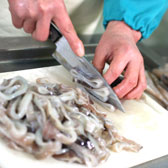 There are two main types of Uo-joyu (fish sauce) in Noto: Ishiri and Ishiru.
Ishiri, is mainly produced in Uchi-ura area, which faces Toyama Bay and it is
made using Ma-ika (a type of Japanese squid). Ishiru originated in the Soto-ura
area facing the Sea of Japan and is made using sardine or mackerel as the main
ingredient. Since both these areas have been known for abundant catches since
old times, fish and other types of sea species were an obvious choice as the
ingredients of Ishiri. While Ishiru is produced in the ports of Wajima ,Takojima
(in Suzu City) and Togi Fukuura (in Shika-machi), ‘Ishiri’ is produced in the
fishing towns such as Ogi in Noto-cho and Ushitsu.
There are two main types of Uo-joyu (fish sauce) in Noto: Ishiri and Ishiru.
Ishiri, is mainly produced in Uchi-ura area, which faces Toyama Bay and it is
made using Ma-ika (a type of Japanese squid). Ishiru originated in the Soto-ura
area facing the Sea of Japan and is made using sardine or mackerel as the main
ingredient. Since both these areas have been known for abundant catches since
old times, fish and other types of sea species were an obvious choice as the
ingredients of Ishiri. While Ishiru is produced in the ports of Wajima ,Takojima
(in Suzu City) and Togi Fukuura (in Shika-machi), ‘Ishiri’ is produced in the
fishing towns such as Ogi in Noto-cho and Ushitsu.
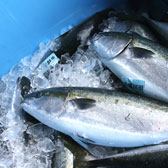 There are a number of different theories about the origin of the word “Ishiri”; however, the most common theory states that in ancient Japanese lanaguage, fish was called “io” or “i’ and therefore Ishiri or Ishiru is a corrupted form of Io-shiru. Ishiri is also known as “Yoshiru” or “Yoshiri”, which means “soup with extra amount of fish” and when it is pickled with salt, it is called as “Shio-shiru” or “Shio-shiri”.
There are a number of different theories about the origin of the word “Ishiri”; however, the most common theory states that in ancient Japanese lanaguage, fish was called “io” or “i’ and therefore Ishiri or Ishiru is a corrupted form of Io-shiru. Ishiri is also known as “Yoshiru” or “Yoshiri”, which means “soup with extra amount of fish” and when it is pickled with salt, it is called as “Shio-shiru” or “Shio-shiri”.  “Nam pla” of Thailand or “Nuoc cham” of Thailand are famous worldwide as fish sauce. In Japan, there are several Japanese varieties of fish sauce such as “Shotssuru” of Akita Prefecture or “Ikanago” of Kagawa Prefecture. All these Japanese varieties use fish as the basic ingredient. Among these different varieties, Noto Peninsula’s Ishiri boasts of the biggest production volumes in Japan.
“Nam pla” of Thailand or “Nuoc cham” of Thailand are famous worldwide as fish sauce. In Japan, there are several Japanese varieties of fish sauce such as “Shotssuru” of Akita Prefecture or “Ikanago” of Kagawa Prefecture. All these Japanese varieties use fish as the basic ingredient. Among these different varieties, Noto Peninsula’s Ishiri boasts of the biggest production volumes in Japan.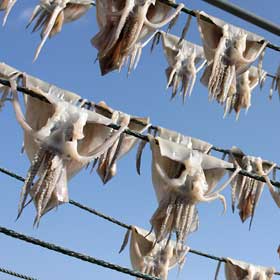 Among different varieties of fish sauce from Noto, Ishiri is produced only in Noto-cho. It is prepared using intestines of Ma-ika (Japanese squid) and is fermented naturally before during maturation. Ogi harbor in Noto-cho is one of the 3 major centers for high-volume squid fishing, alongside Hakodate (Hokkaido) and Hachinohe (Aomori) and from the old times, fresh squid has been available in abundance. This is the reason why the area is suited for the production of Ishiri, which uses intestines of Ma-ika. It is not unusual for one producer to manage every step of the production, from procurement of required ingredients to processing, production as well as sales. Ishiri has a soft, homemade taste. It is a special product unique to this area.
Among different varieties of fish sauce from Noto, Ishiri is produced only in Noto-cho. It is prepared using intestines of Ma-ika (Japanese squid) and is fermented naturally before during maturation. Ogi harbor in Noto-cho is one of the 3 major centers for high-volume squid fishing, alongside Hakodate (Hokkaido) and Hachinohe (Aomori) and from the old times, fresh squid has been available in abundance. This is the reason why the area is suited for the production of Ishiri, which uses intestines of Ma-ika. It is not unusual for one producer to manage every step of the production, from procurement of required ingredients to processing, production as well as sales. Ishiri has a soft, homemade taste. It is a special product unique to this area.
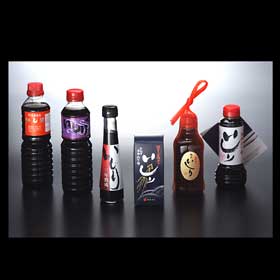 Commonly, Noto-cho’s Ishiri is prepared from late autumn to early winter and is ready by late summer or autumn of the following year. However, the local Ishiri is matured for 1 to 2 years, so that it gets a more mellow taste. Each producer prefers creating his own unique taste of Ishiri. The usual process of Ishiri making includes removing the ‘goro’ or the intestines of the squid, pickling them with salt and letting them ferment naturally before they mature. The final product that people see in the shop takes 1~3 years to be completed and it is a result of traditional processing and manufacturing techniques handed down through generations.
Commonly, Noto-cho’s Ishiri is prepared from late autumn to early winter and is ready by late summer or autumn of the following year. However, the local Ishiri is matured for 1 to 2 years, so that it gets a more mellow taste. Each producer prefers creating his own unique taste of Ishiri. The usual process of Ishiri making includes removing the ‘goro’ or the intestines of the squid, pickling them with salt and letting them ferment naturally before they mature. The final product that people see in the shop takes 1~3 years to be completed and it is a result of traditional processing and manufacturing techniques handed down through generations.
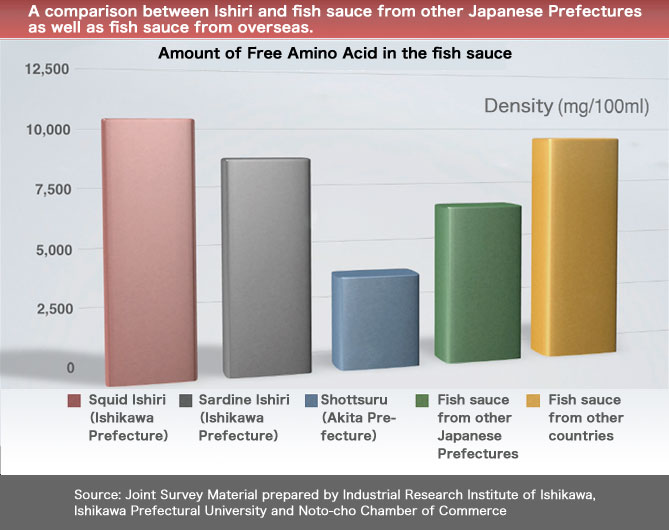

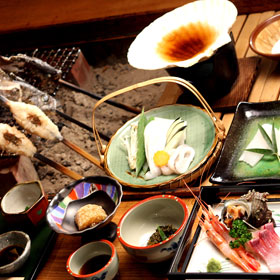 Noto-cho’s Ishiri can be used with a variety of food ingredients and it is
especially goes well with Sashimi (raw fish), Asazuke (lightly pickled food),
Nimono (boiled foods), and Nabe (soup stock dishes with seafood or meat). ‘Ishiri’s
Kaiyaki’ (grilled scallop with Ishiri) is one of the most famous recipes of
Noto-cho. Ishiri fish stock is put in the shell of a large scallop and then
broiled with other ingredients such as squid, small slices of eggplant, enoki mushrooms,
green onions and Japanese. Once it starts simmering, it is ready to eat. One
bite and your mouth will be filled with the tasty sweetness of the vegetables
and Ishiri’s umami flavor. Ishiri goes well, not only with the local
cuisine but only a few drops of Ishiri used in Japanese, Chinese or Western
recipes are enough to give the recipe a unique flavor.
Noto-cho’s Ishiri can be used with a variety of food ingredients and it is
especially goes well with Sashimi (raw fish), Asazuke (lightly pickled food),
Nimono (boiled foods), and Nabe (soup stock dishes with seafood or meat). ‘Ishiri’s
Kaiyaki’ (grilled scallop with Ishiri) is one of the most famous recipes of
Noto-cho. Ishiri fish stock is put in the shell of a large scallop and then
broiled with other ingredients such as squid, small slices of eggplant, enoki mushrooms,
green onions and Japanese. Once it starts simmering, it is ready to eat. One
bite and your mouth will be filled with the tasty sweetness of the vegetables
and Ishiri’s umami flavor. Ishiri goes well, not only with the local
cuisine but only a few drops of Ishiri used in Japanese, Chinese or Western
recipes are enough to give the recipe a unique flavor.
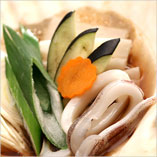

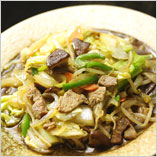
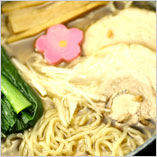
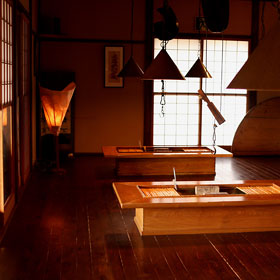 Sannami is a traditional guesthouse, located in Noto-cho, offering local cuisine. This establishment can accommodate only 3 guests a day and many food aficionados come to Sannami from not only Japan but from all over the world to enjoy its unique recipes. The Chef uses homemade Ishiri and the simplicity of the taste is becoming quite popular. This place has also been introduced in a number of travel magazines and was awarded ‘Best Taste Award’ in the ‘Peaceful Inn Cuisines’ category in a recent magazine edition published in February 2009.(
Sannami is a traditional guesthouse, located in Noto-cho, offering local cuisine. This establishment can accommodate only 3 guests a day and many food aficionados come to Sannami from not only Japan but from all over the world to enjoy its unique recipes. The Chef uses homemade Ishiri and the simplicity of the taste is becoming quite popular. This place has also been introduced in a number of travel magazines and was awarded ‘Best Taste Award’ in the ‘Peaceful Inn Cuisines’ category in a recent magazine edition published in February 2009.(

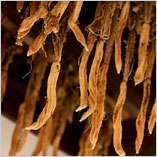
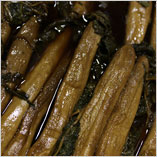

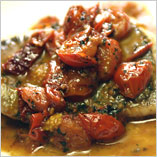

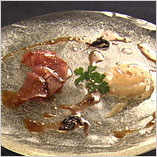

 When the World Cuisine Summit was held in Tokyo in February of 2009. The purpose of this ‘Food Festival’ was to disseminate and promote information regarding Japanese food and culinary skills and the essence of Japanese food culture.
Noto-cho’s Ishiri made a great impression on the visitors to this summit venue. Ben Flatt’s special potato soup with Ishiri was also a big hit with everyone who tried it. The unique umami flavor proved very popular with everyone. At a time when Japanese Food is becoming a craze all over the world, 21 top chefs from 8 countries gathered in Japan for this summit. In the midst of all this, Ishiri left a lasting impression as an ‘all-purpose sauce’ on the participants of the summit.
When the World Cuisine Summit was held in Tokyo in February of 2009. The purpose of this ‘Food Festival’ was to disseminate and promote information regarding Japanese food and culinary skills and the essence of Japanese food culture.
Noto-cho’s Ishiri made a great impression on the visitors to this summit venue. Ben Flatt’s special potato soup with Ishiri was also a big hit with everyone who tried it. The unique umami flavor proved very popular with everyone. At a time when Japanese Food is becoming a craze all over the world, 21 top chefs from 8 countries gathered in Japan for this summit. In the midst of all this, Ishiri left a lasting impression as an ‘all-purpose sauce’ on the participants of the summit.